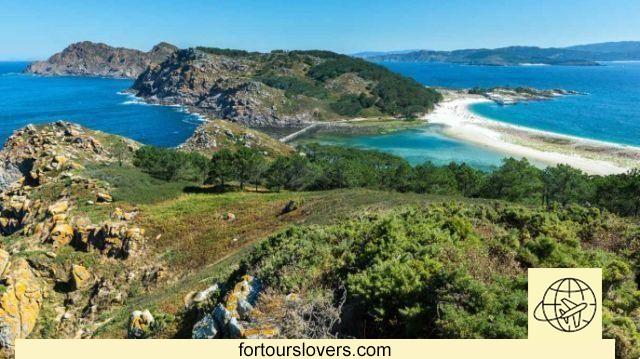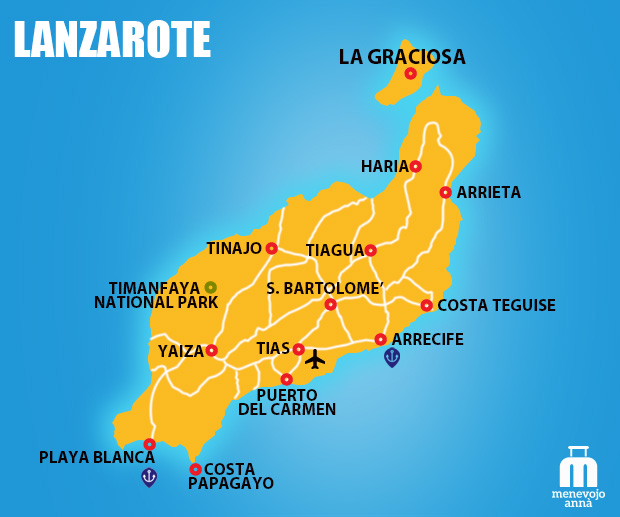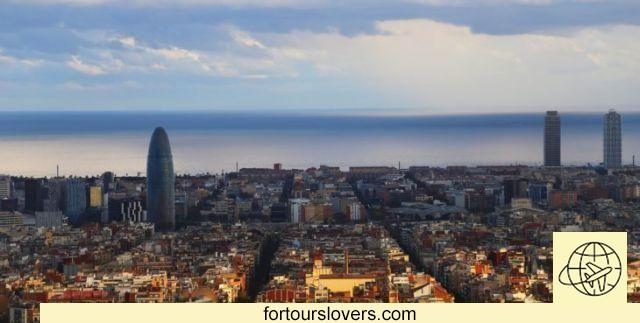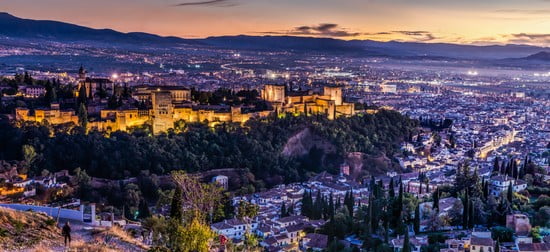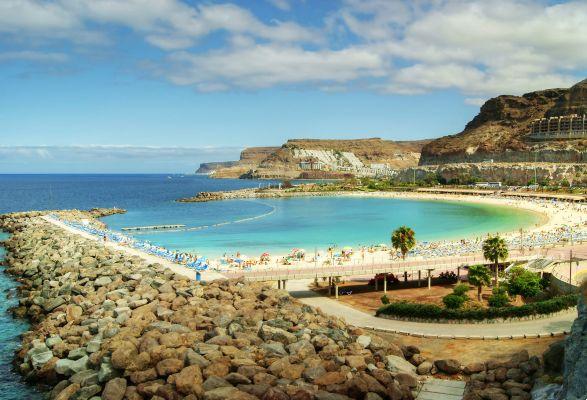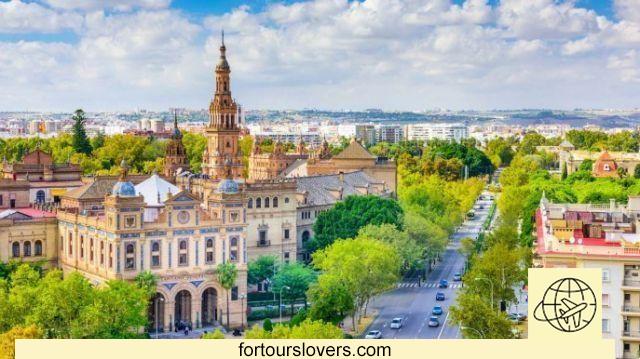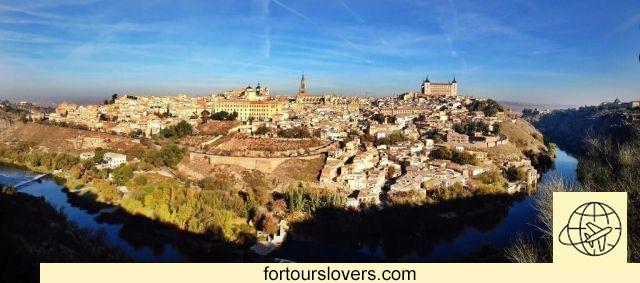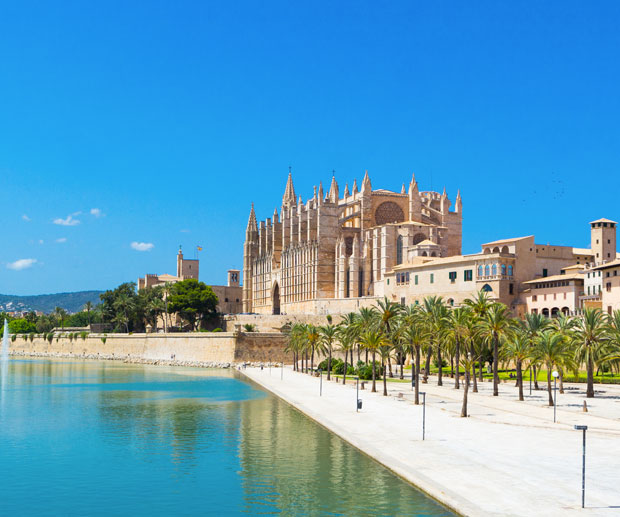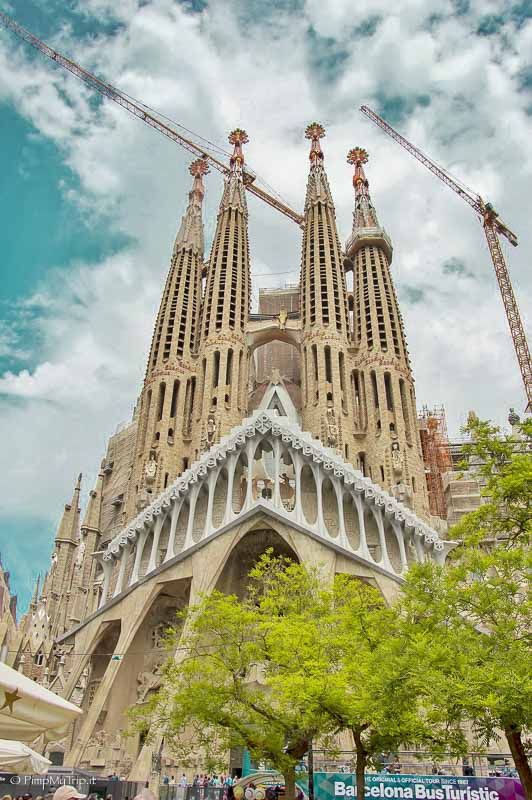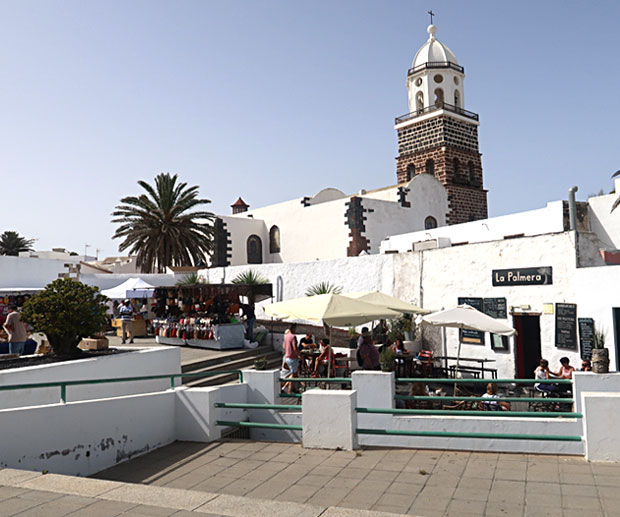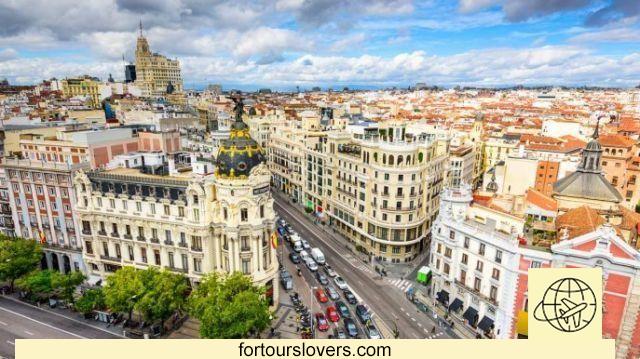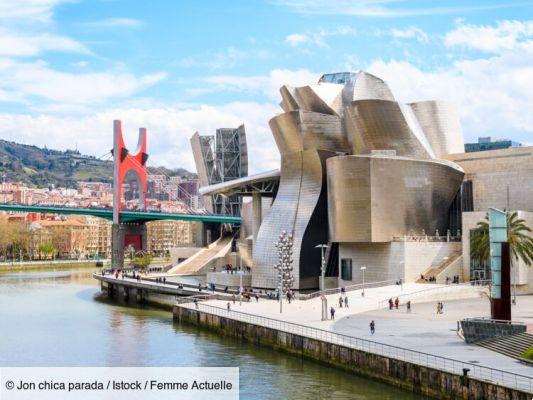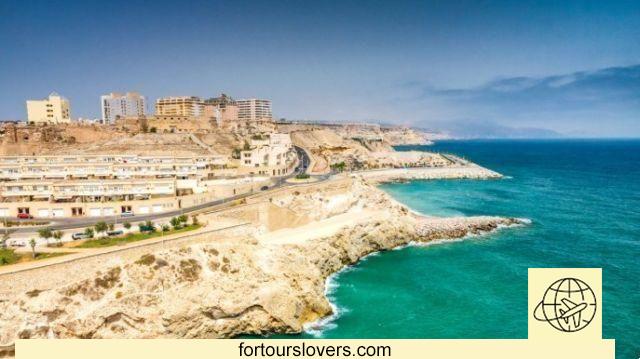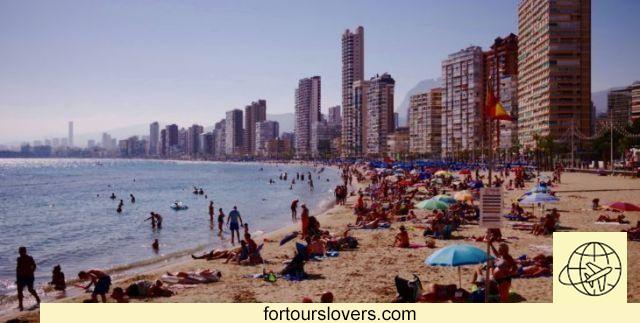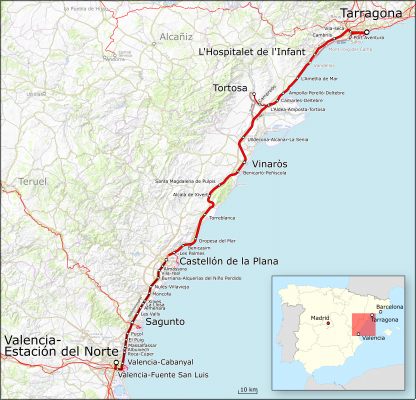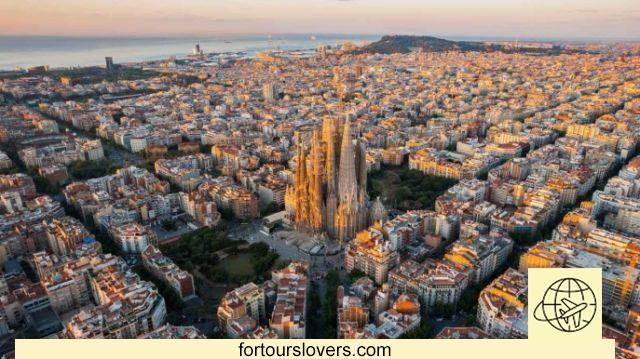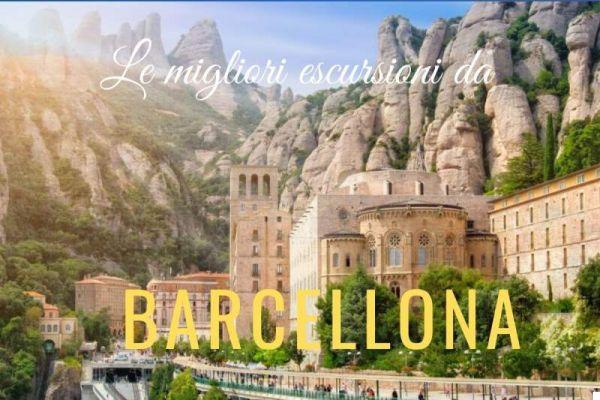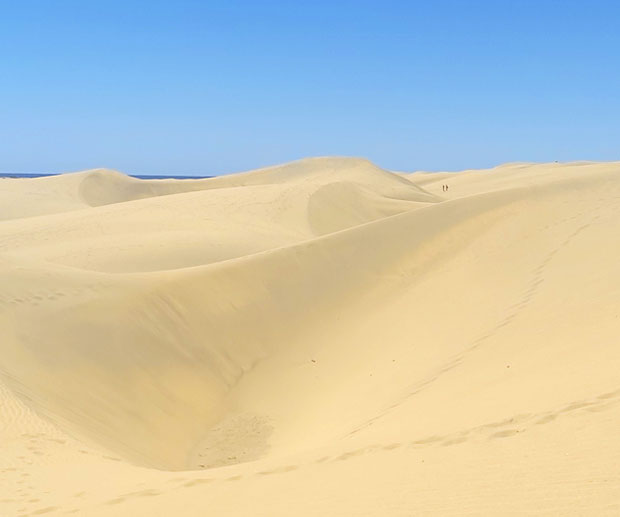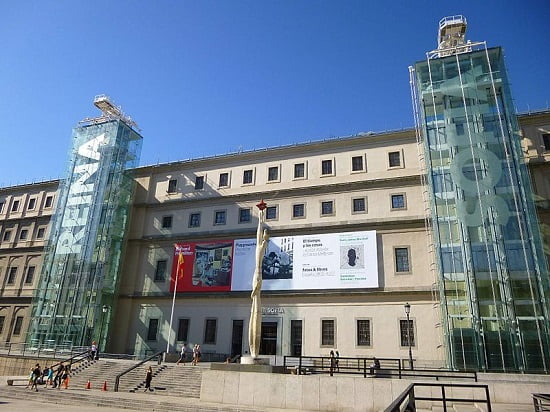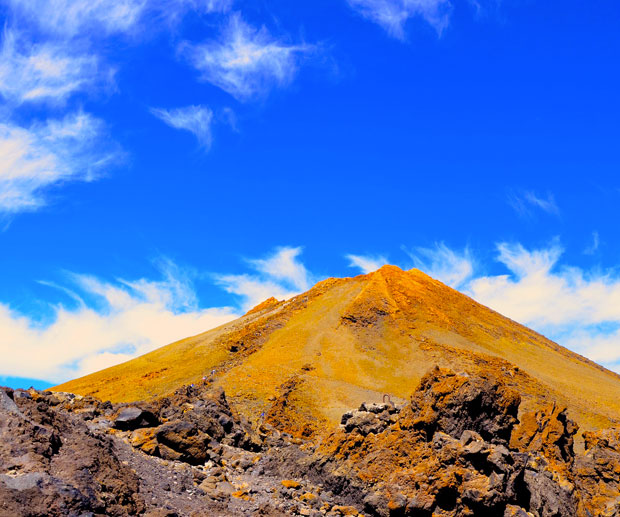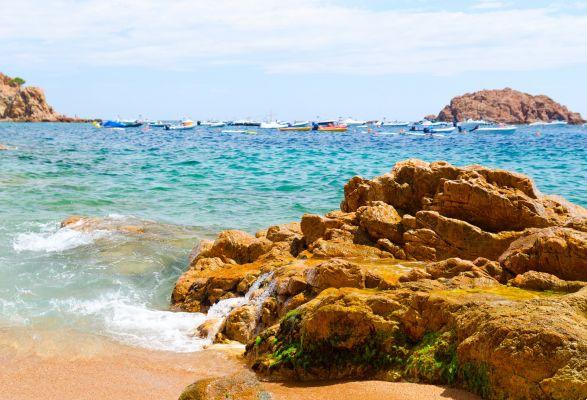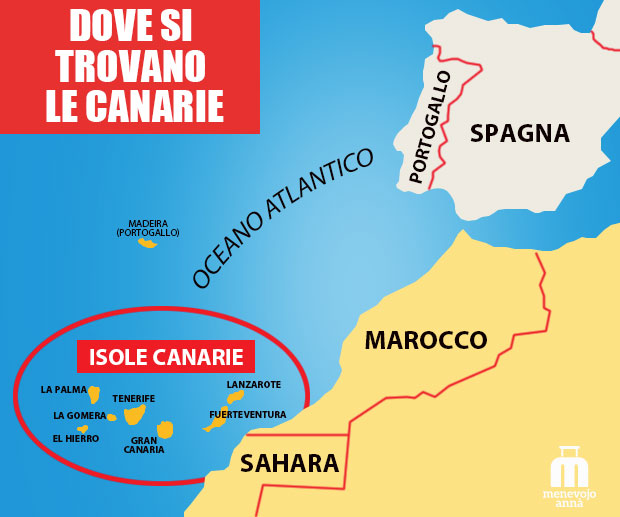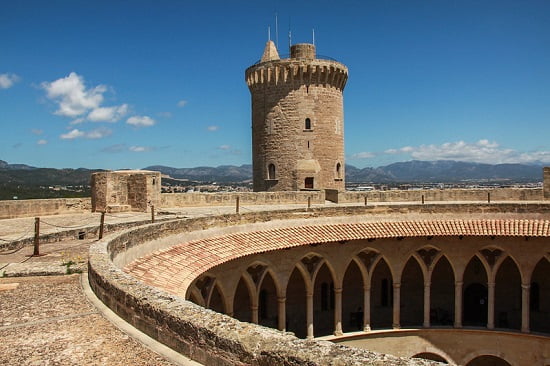After the post on On The road in Corsica in moto, Marco and Serena return to the blog with a new one itinerario, this time to discover the Northern Spain, from the Pyrenees to the Atlantic Ocean, crossing in the footsteps of pilgrims on the way to Santiago de Compostela.
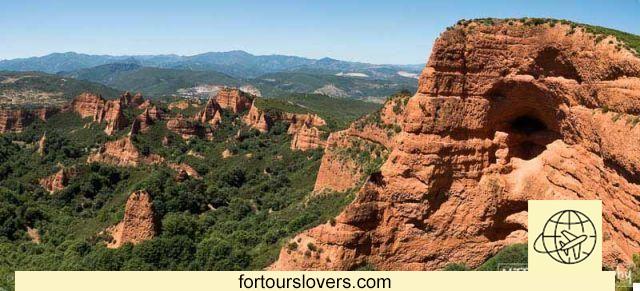
Panorama of the Mirador de Orellán
La Spain it is the most mountainous country in Europe after Switzerland and boasts an unparalleled topographical heterogeneity. This variety is also reflected in the character and language of the inhabitants of the various regions: a reality made up of regional differences and tenacious local traditions, festivals and typical dishes stands out.
In addition to Castilian, the language that we are all led to identify as "Spanish", are also official Basque, Catalan and Galician.
This implies that crossing these regions one cannot help but notice the changing language used on road signs, shop signs, advertising posters, restaurant menus and so on.
I have found very few people who can understand English, for example at hotel reception, where you would expect a certain command of the language given the high influx of tourists from all over the world.
It has many similarities and is therefore more understandable, but contrary to popular belief, it is not enough to add an "S" at the end of the words to make them Spanish.
I therefore recommend that you at least learn the basics of the Spanish language before leaving.
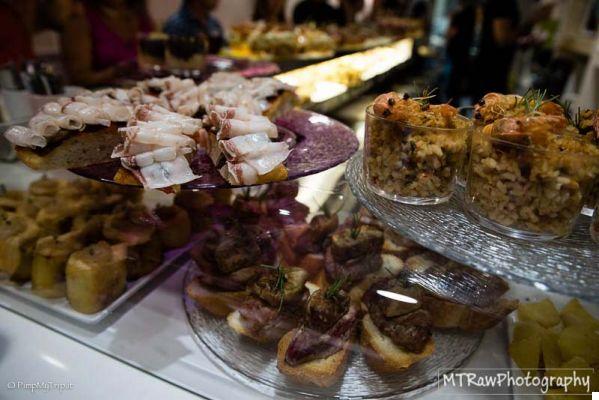
Tapas bar Meli Melo in Zaragoza
One thing that unites the entire population, however, exists and concerns the times that mark the rhythm of the day. These are generally a couple of hours ahead of ours, a bit like an unofficial time zone. For example, don't expect to find any shop open before 10am, except perhaps for bakeries and huge supermarkets which don't open before 9am anyway.
At the same time it is very difficult to have lunch before 14 even if in areas with high tourist turnout perhaps you can find something open even at 13; dinner is no exception, as restaurants hardly open before 21pm and start to get crowded after 22pm.
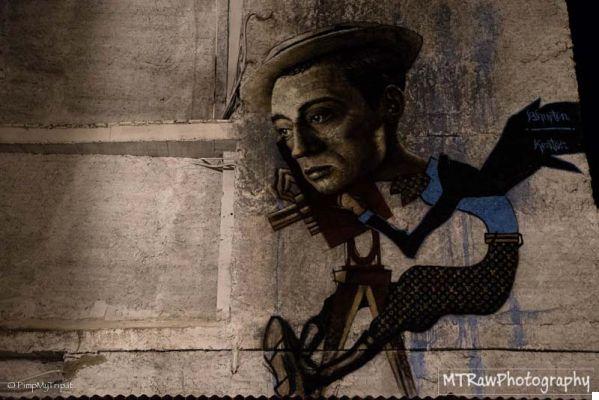
A very common custom is to decorate bare walls of buildings with wonderful murals, as in this case, in Huesca
La road network it is very well managed and cared for, not only for what concerns the highways, but also the secondary roads.
The main highways are called autopistas and are identified with the initials AP followed by the relative number on green signs, often flanked by the European abbreviations (starting with the letter E).
In the shorter sections the toll is fixed but in general you take the ticket at the entrance to the motorway and pay according to the distance traveled, in the same way but with rather high rates that make them even less busy.
Alongside the toll highways run the autovias: identified by the initial letter A on blue signs, motorways are comparable to autopistas but a toll free and you can often go from stretches of autopista to sections of autovia.
Le service stations there are many along the autopistas, but this is not the case for the autovias from which it is necessary to go out and walk a few more kilometers before reaching one, even if they are always well signposted.
If you are not particularly in a hurry, I recommend that you take the carreteras national: free national highways whose initials begin with the letter N on blue signs, which sometimes have only one lane in each direction and travel roughly the same route as the motorways: while inevitably adding kilometers to the journey, they allow you to cross countries and places not visible from the highway.
Speed limits and road regulations in general are almost similar but more controlled and sanctioned. Will find useful information on the ACI website.
Itinerary
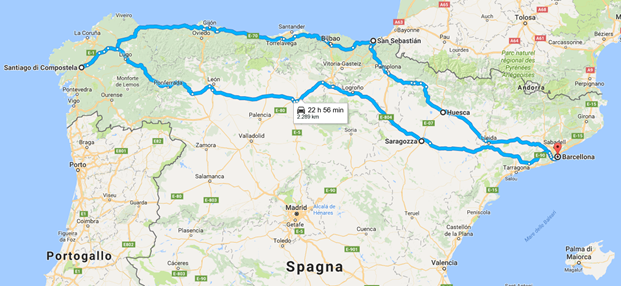
The travel itinerary
The itinerary we have decided to follow starts from Barcelona, crosses the Aragonese Pyrenees, touches Navarre, follows the Atlantic coast of the Basque Country, Cantabria and Asturias up to Santiago de Compostela in Galicia, to then go back through the regions of Castile-Leon, La Roja, Aragon and finally ends at its starting point in Barcelona: a total of about 2300 km on the map which then, between detours and places inserted along the way, they easily grew to around 3000 spread over two weeks.
Since it is the first trip we face with this amount of kilometers, we decided to arrive in Spain by ferry. Starting from Genoa, the choice of the shipping company was practically obligatory, given that the only one to travel the Genoa-Barcelona route is Grandi Navi Veloci. Having booked in April with departure mid-July and choosing to include cabin and meals, the total price was 648 euros for two people with a round trip motorbike.
In hindsight I don't feel like recommending this choice, due to delays and poor cleaning in the cabins. We will probably go directly to the bike next time.
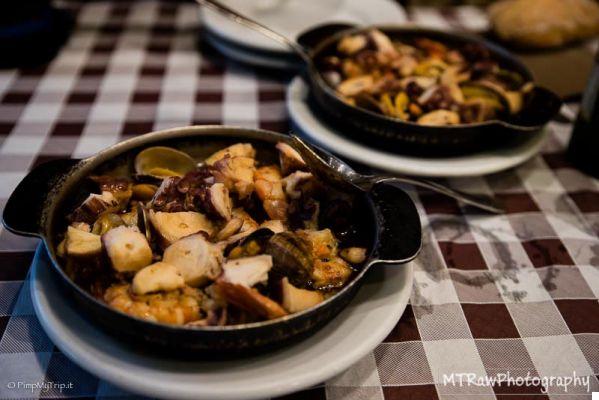
Casserole with octopus, shellfish and seafood, savored in Asturias
Stages
- day 1: Leiden, Huesca
- Day 2: trip to the Pyrenees: Castillo de Loarre, Los Mallos, Riglos
- Day 3: Pamplona, Hondarribia and San Sebastian (Donostia)
- Day 4: San Sebastian: beach and tour of the town
- Day 5: Bilbo (Bilbao), Laredo and Santander
- Day 6: Comillas; Gijon
- Giorno 7: Luarca, Beach of the Cathedrals and Santiago de Compostela
- Day 8: Santiago de Compostela: tour of the historic city center
- Day 9: Carreirón Natural Park
- Day 10: Las Medulas
- Day 11: Ponferrada, Astorga, Leon, Haro
- Day 12: Tudela, Zaragoza
- Day 13/14: Barcelona
Day 1: Leiden and Huesca
Disembarking from the ship later than expected, we immediately headed towards Huesca, stopping about halfway in the town of Lleida(in Castilian Lérida). Here, after parking in the nineteenth century Rambla de Ferran fringed with trees, we took a quick tour of the Piazza della Paeria.
The next stop was to visit the Your Vella (old cathedral) that dominates the center from the top of a hill, reachable by a suitable free public lift. Admission: only the cathedral € 5, adding € 2 can also be visited La Suda (The King's Castle).
After the quick visit of Lleida we headed to Huesca, where we stayed two nights taking advantage of the fact that besides being an important Aragonese crossroads, it is the last town in the plain before the slopes of the Pyrenees.
Il Old Town is located on a hill and represents the heart of the city with pedestrian streets, shops, restaurants and the most important monuments among which stand out the town hall, or the town hall, the cathedral which towers over the same square and, even more impressive, the church San Pedro the Elder.
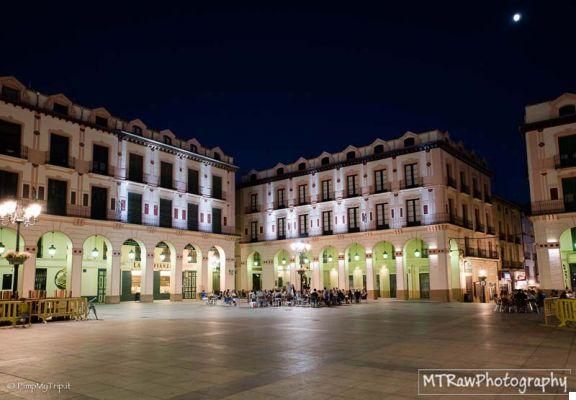
Square in the historic center of Huesca
Thanks to the reviews on the web we have identified a very nice place to go for dinner: Comomelocomo. The menu offers, in addition to various sandwiches, appetizers and many tapas, a wide choice of dishes that can be ordered both in the “ration” version, ie a whole portion, and as a “tapa”, ie half a portion. Total shopping for two € 25,30 savoring various tapas, dessert and cerveza.
Giorno 2: Loarre Castle, Los Mallos, Riglos, San Juan de la Peña Monastery, Jaca
On day 2 we dedicated ourselves to visiting the Castle of Loarre: a splendid manor perched on a rocky spur dating back to the XNUMXth century and presumably the oldest Spanish castle.
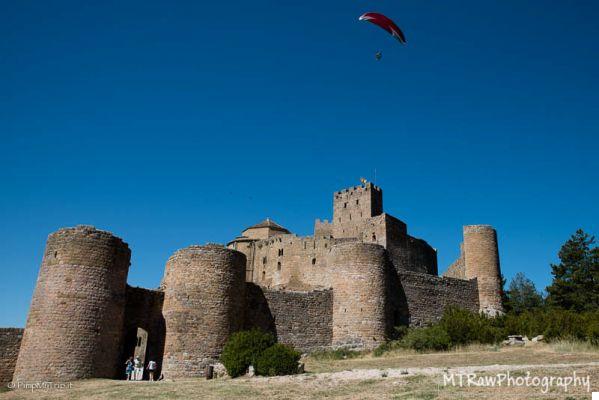
Castle of Loarre
Then we headed to Riglos, a tiny village that rises at the foot of the enchanting pink cliffs called Los Mallos, on whose slopes magnificent eagles nest. Various paths start from here, some of which are equipped with via ferratas that lead up to the peaks of the Mallos. We limited ourselves to visiting the village and having lunch with sandwiches stuffed with chorizo, the typical salami, and local cheese.
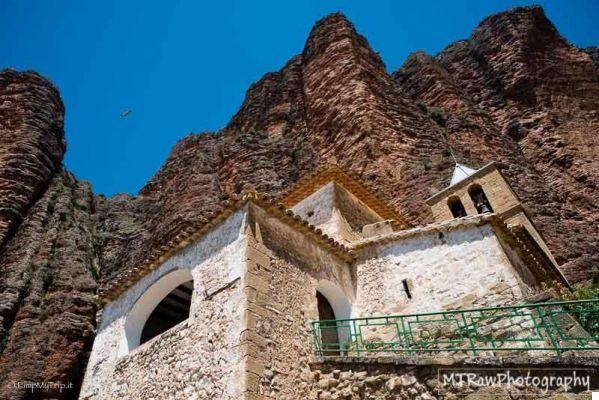
Riglos church at the foot of Los Mallos
From Riglos we are back on the saddle to tackle the long and winding path that leads to Monastery of San Juan de la Peña, which in reality is not a monastery but two: an older one dating back to the tenth century and a more recent one built in the eighteenth century, next to which there is the ticket office and in front of a park, equipped with free parking, picnic tables and a small bar.
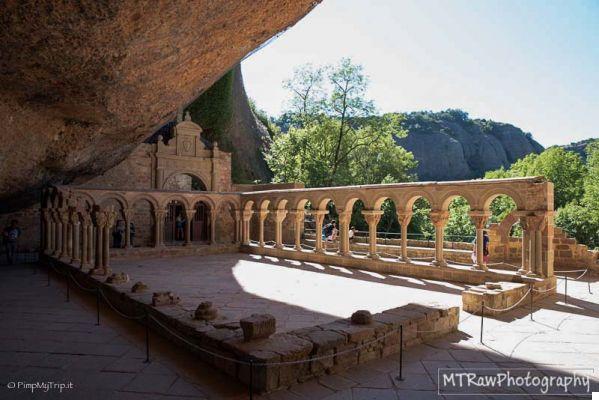
Internal chiostro of the Monastery of San Juan de la Peña
Continuing for another 40 minutes you will arrive at Pony, an important Aragonese ski destination that boasts an imposing, unique citadel Citadel survived in Spain, dating back to the late sixteenth century with walls and moat still intact where a herd of deer graze disturbed only by tourists armed with cameras.
Unfortunately, having arrived after 19pm it was not possible to visit it and we therefore returned to Huesca taking a more direct route, taking the Autovia and then the National which brought us back to the city in about an hour.
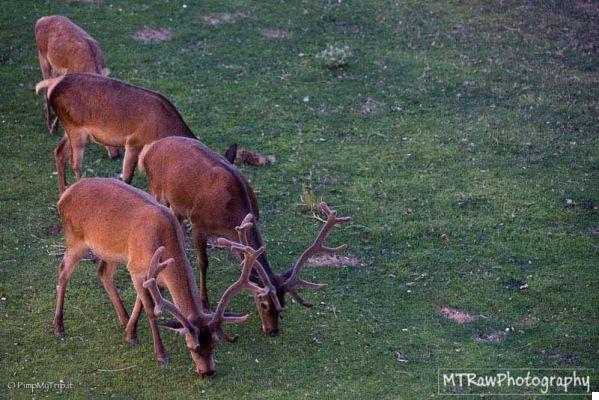
fawns in the moat of the Ciudadela di Jaca
In hindsight I would recommend staying overnight in Jaca to be able to visit it better and also because Pamplona is easily accessible from here, the first stop on the following day.
Day 3: Pamplona, Hondarribia, San Sebastian (Donostia)
Pamplona (Iruña in the local language) is a quiet modern town, famous for the running of the bulls, l'Encierro, which takes place every year from 6 to 14 July on the occasion of the feast of San Firmino.
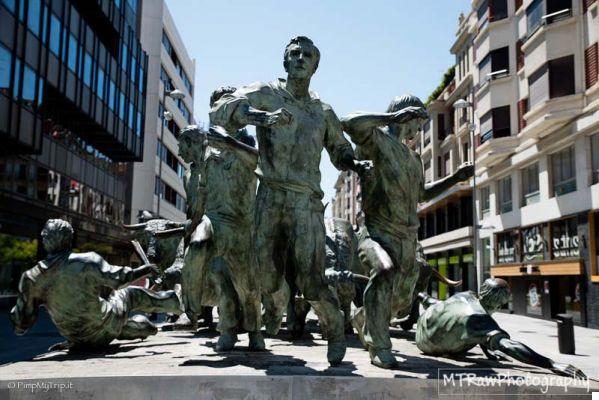
Monument dedicated to the Encierro in Pamplona
After a hearty meal of potato tortillas stuffed with ham, cheese and grilled vegetables, we headed to Hondarribia, a pretty coastal town very close to the French border, whose strategic position justifies the massive fortification of the old city.
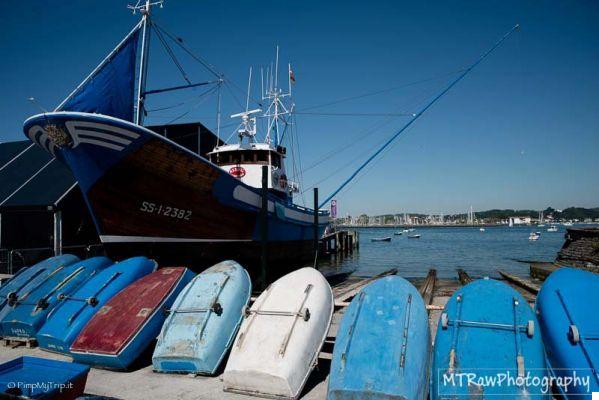
Boats "stretched out in the sun" at the Port of Hondarribia
In the evening we reached the apartment a San Sebastian (Donostia) and we dined not far away in a delightful little place, the Txirrita bar, with fried squid and Lomo (a salami similar to cooked ham) grilled with a side of salad accompanied by the inevitable cerveza, at a price of 19 euros.
Day 4: San Sebastian: beach and tour of the town
We dedicated this day to a little bit of well-deserved rest, if not for us at least for the bike that hasn't moved from the parking lot.
The 12 km long promenade, dotted with sculptures, surrounds three huge free beaches of fine sand, equipped with showers, first aid stations and where it is possible to rent deck chairs and umbrellas.
We enjoyed a nice cooling bath, as the temperature exceeds 40 ° in the central hours of the day: the heat did not prevent us from having lunch based on bocadillo (stuffed sandwich) with potato tortilla in a nice little place in one of the streets. more internal.
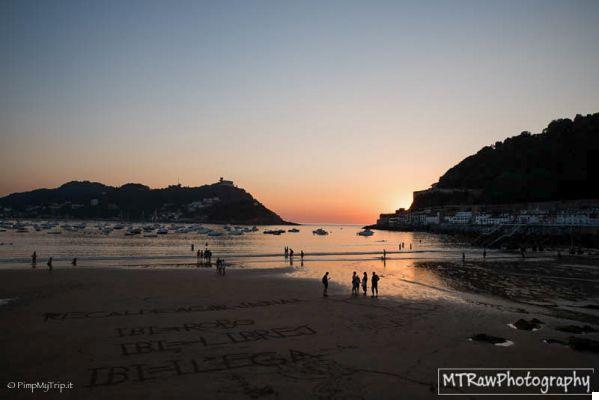
San Sebastian beach at sunset
In the evening we dedicated ourselves to visiting the city. Strolling along the river Urumea, crossing the beautiful bridge dedicated to Queen Maria Cristina, we found ourselves in the old quarter, in Pier walk.
Entering the maze of narrow streets we found ourselves in front of the heavy Baroque facade of the church of Santa Maria, placed at the beginning of August 31st Street. Continuing along this same street you will find another historical site: the Dominican convent of San Telmo.
Staying in the same neighborhood you can't help but cross Constructiòn Square, a large arcaded square where the numbered balconies of the buildings were once reserved for spectators of the bullfights that took place inside.
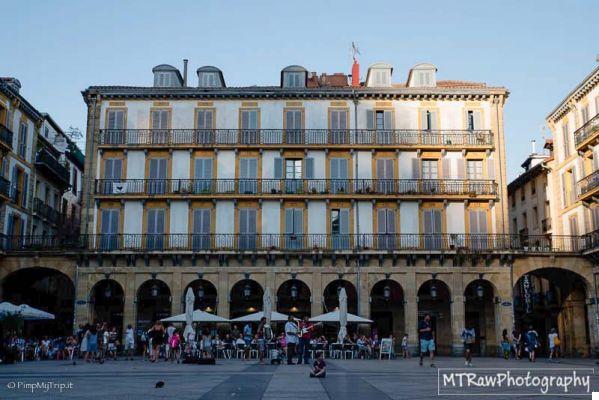
Constructiòn Square
Day 5: Bilbo (Bilbao), Laredo, Santander
We left early in the morning for Bilbo (Bilbao) where, to reach the center, you cross a huge bridge whose futuristic architecture amazes and from which you can already glimpse the non-conformist structure of the museum of modern art Guggenheim.
From here starts the 3 km long "avenue of sculptures" that ends with a pedestrian bridge over the Ria del Nerviòn with glass bottom. Crossing the modern city you arrive at the hull came (old city) leaning against the cathedral and a few steps away New Square with cafes and shops.
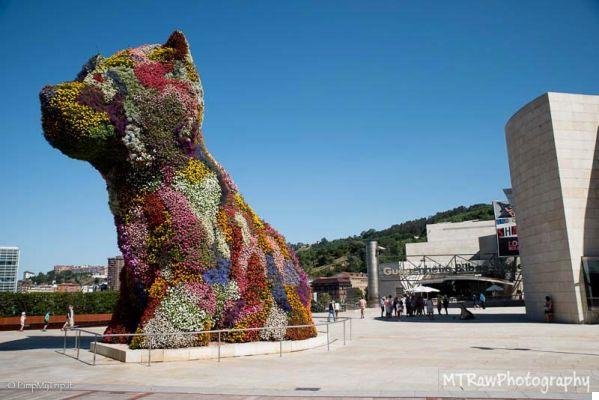
Floral sculpture in front of the entrance to the Guggenheim museum
After lunch we continued on to Laredo, a populous seaside resort on the Cantabrian coast that extends over a coastline of over 5 km, where we relaxed for a couple of hours comfortably lying on the immense beach of fine white sand and equipped with free showers.
In the evening we came to Santander and, after having dinner at the Taberna La Pirula, we took a romantic stroll along the seafront in the light of a beautiful full moon.
Walking along the promenade one cannot help but notice the Casino belle-epoque illuminated in day and overlooking the famous Sardinero Beach which stretches to the north.
Among the sumptuous villas that can be admired, that of Emilio Botin, president of the Banco Santander, the largest Spanish bank and the post office: the Post. Heading towards the center meets the cathedral, dating back to the twelfth century, formed by two superimposed buildings connected by an imposing external lateral staircase.
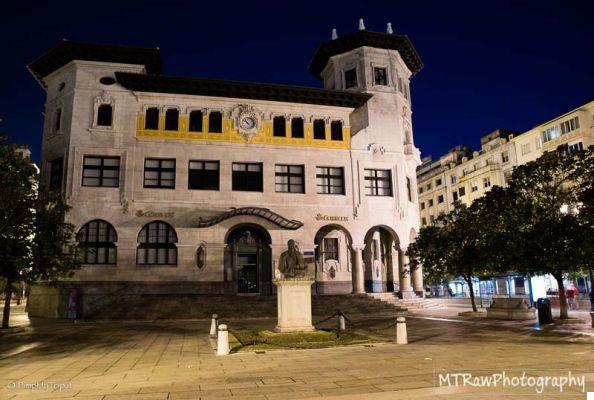
The Correos
Day 6: Comillas, Gijon
First stop: town of Quotation marks, a small town that hosts three unmissable architectural treasures. On the top of a hill, surrounded by a well-kept public park, stands the marvelous neo-Gothic palace of Sobrellano, designed by the modernist architect Joan Martorell.
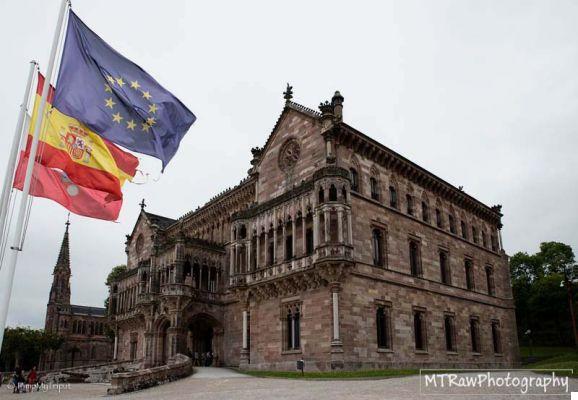
The neo-Gothic palace of Sobrellano. In the background, the chapel of the Marquis
Next to it is the chapel of the Marquis and, continuing along the downhill avenue, you will find the Capriccio by Gaudi, an original and colorful building also known as Villa Quijano, covered largely with exposed bricks and glass ceramic tiles in the shape of sunflower leaves and flowers, which is one of the famous architect's first relevant works. Admission 5 euros each.
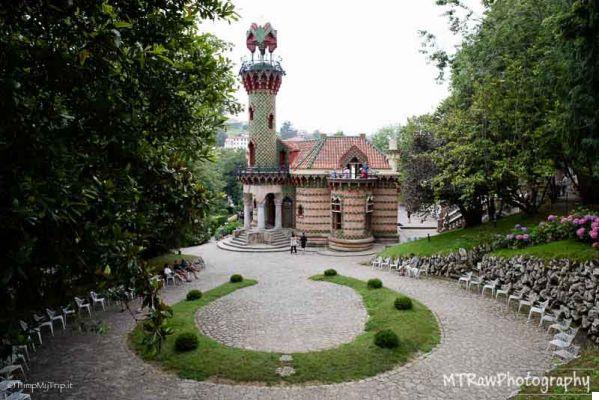
The Capriccio of Gaudi
After having devoured a good boccadillo with chorizo and cheese comfortably seated on a park bench, we left for Gijon. Strolling towards the old historic fishermen's quarter, Cimadevilla, which separates the coast in two, you can enter the Cerro (hill) de Santa Catalina, an ancient military fortress now transformed into a public park, and climbing up one of the many paths that crisscross the manicured lawns you reach the praise of the Horizonte, a modern sculpture in reinforced concrete placed at the highest point of the hill facing the sea, from which you can enjoy a breathtaking view of the ocean.
For dinner I highly recommend choosing one Sidreria. Gijon, in fact, is considered the Spanish capital of cider production or the Cider, in Spanish. In addition to being free of additives and chemicals and therefore healthy, it is also very economical, as a half-liter bottle costs less than 3 euros. Also having a low alcohol content it is easy to consume more than one bottle at dinner, but be careful not to drive afterwards!
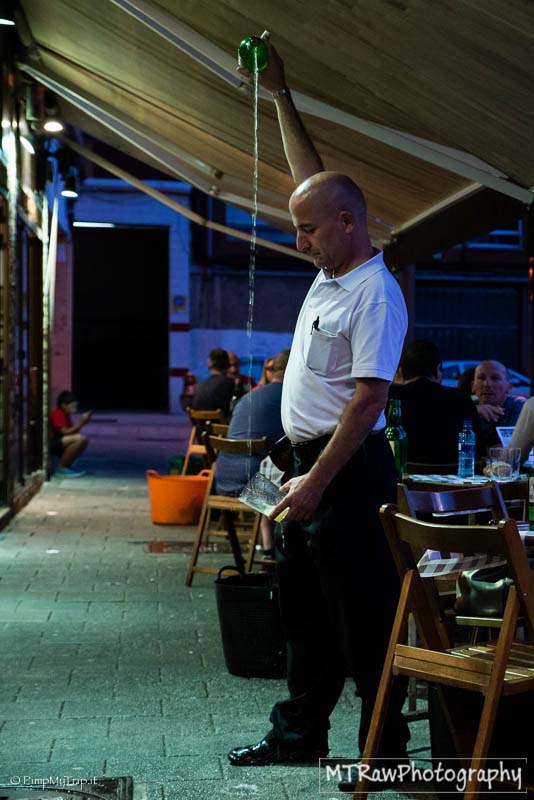
Waiter pouring the Sidra
But the real peculiarity is that the waiters blatantly pour the sidra holding the bottle raised high on the head, while the glass is held low and filled only one culin at a time, which is equivalent to a couple of fingers, and tradition has it that it should be drink by the drop. For dinner we went to the Sidreria Nava where we tasted a pan with octopus, shrimp and seafood that was the end of the world. Expense: 36 euros for two.
Giorno 7: Luarca, Beach of the Cathedrals and Santiago de Compostela
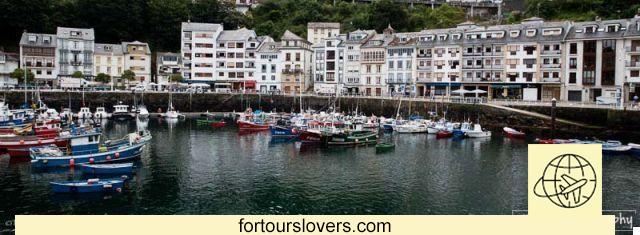
Luarca harbor
Continuing our traveling journey, in the morning we stopped at Luarca, a delightful fishing village whose fishing port is formed by a bay fringed with cider houses into which the sinuous Rio Negro stream flows. The old town stands on a steep slope on the hill at the end of the harbor.
Along the Atlantic coast, along the Carretera Cantabrica, we took the signposted exit for Las Catedrales, immediately after Ribadeo. Here is the famous beach Beach of the Cathedrals characterized by particular rocky conformations carved by the tide with natural arches up to 10 meters high that can be traveled during low tide.
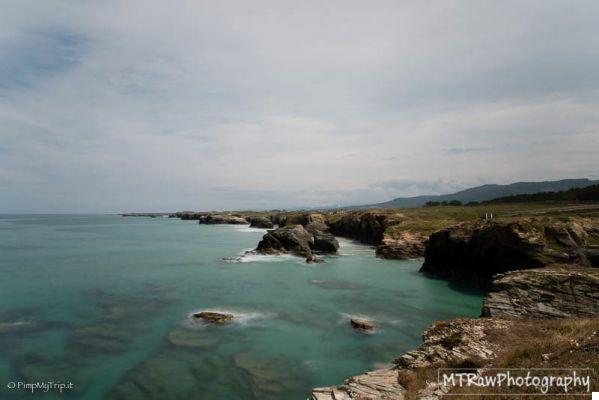
Scogliera limitrofa to the Beach of the Cathedrals
During the busiest months, to preserve the natural beauty of the place, the entrance is reserved for a limited number of people spread over the day: it is therefore necessary to book the visit in advance.
In the evening we finally came to Santiago de Compostela where we dined in the excellent restaurant Cabildo couple.
Day 8: Santiago de Compostela
The day was entirely dedicated to the visit of Santiago de Compostela, known and reached by pilgrims from all over Europe for more than a millennium.
The main attraction is the cathedral dedicated to St. James, built in the ninth century together with the relative infrastructures aimed at welcoming pilgrims, who were directed along pre-established routes equipped with hostels, sanctuaries and churches, favoring the spread of Christianity throughout the Northern Spain.
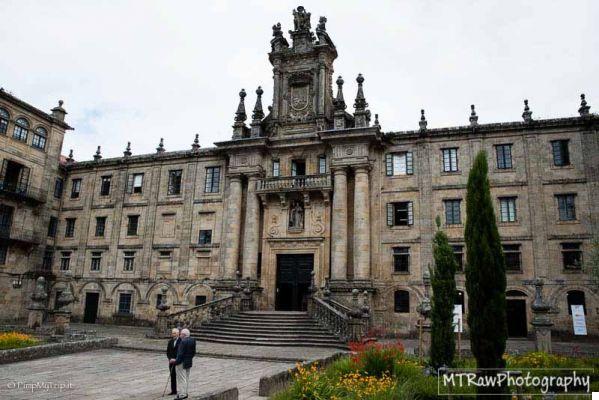
University museum in Santiago de Compostela
Even today, the most popular is the medieval route known as “Via Francese”, which starts from Le Puy in France and crosses the Pyrenees and whose best-known stages are: Pamplona, Leon, Astorga and Ponferrada.
For more information: http://www.caminodesantiago.gal/es/inicio also in English.
In addition to the cathedral and the historic center in general, surrounded by churches, museums and historic buildings, the Food Market, especially on the busiest days such as Tuesdays and Saturdays, when dozens of women from neighboring villages sit behind baskets full of local agricultural products.
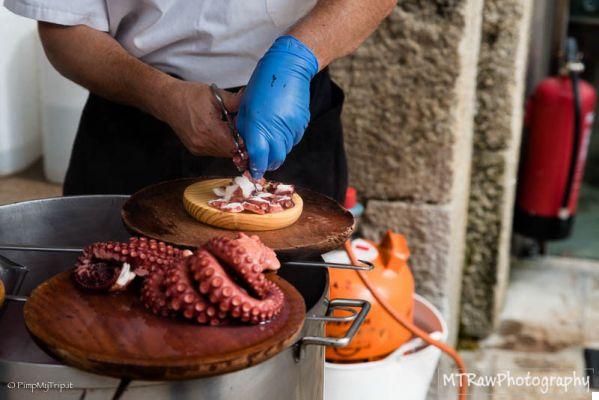
Street food in the Mercado de Abastos
Very nice and relaxing Alameda Park where you can walk on the various paths among oaks, poplars and eucalyptus trees, far from the chaos of the city crowded with tourists and pilgrims.
This merges with another park: the Carbelleira of Santa Susana, populated by centuries-old oak trees, where the church of Santa Susana, also patron saint of the city, is located. From the belvedere you have a splendid view from above over the historic center and the cathedral.
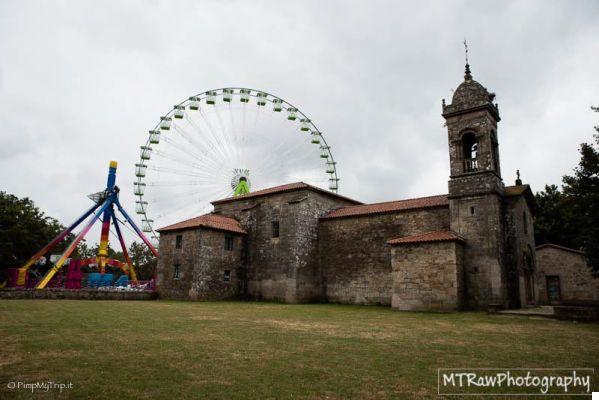
The sacred and the profane meet: an itinerant funfair next to the Church of Santa Susana
Day 9: Carreirón Natural Park
Il Carreirón Natural Park is probably one of the points of the Rìax Baixas remained closer to the original natural state and is located at the southern end of theIlla de Arusa, a wooded peninsula about 60 km away from Santiago de Compostela.
It is therefore worthwhile to drive an hour to stroll along its paths between isolated beaches, moors and brackish lagoons which in some seasons give hospitality to migratory seabirds such as waders, herons and ducks.
There are two possible routes that go around the promontory marked by a board near the free car park: the longest has 3,6 km while the second which cuts through the center of the park shortens to 2,5 km. We have chosen to follow the longer route, entering the woods that follow the south bank of theBrava Cove.
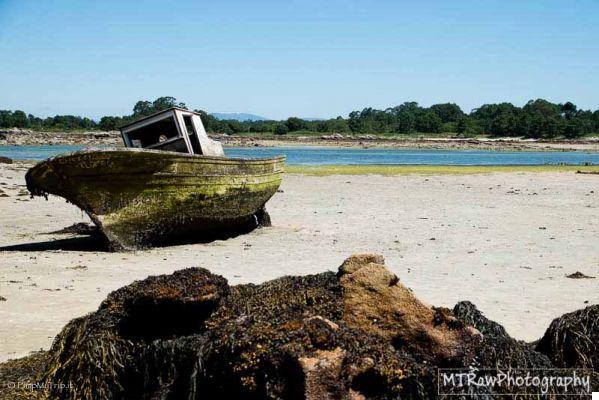
Carreirón Natural Park
There are a few viewpoints to take note of: Punta da Cruz, from which you can admire a splendid view of the ocean and turning south-west you can see the town of O Grove and the island connected to it, A Toxa, while yachts and fishing boats roam among the smaller islets. Further on there is the small strip of sand between the rocks Margaritas Beach, where the paths meet.
Always continuing on the longest route you will arrive at Ottereira Beach, behind which there is a brackish lagoon where water birds gather. Finally, go up towards the east, where the stretches of beach are longer and more sandy such as the Praia de Salinas, where you can swim in complete safety.
Day 10: Las Medulas
Just before reaching Ponferrada we took the turn for Orellán headed towards The Medulas. This immense archaeological site, declared a World Heritage Site by UNESCO in 1997, takes your breath away for the grandeur and beauty of its canyons that may mistakenly seem natural, but whose true history is even more than incredible.
The green mountain, covered by gorse and colossal and gnarled walnut trees, seems to have been cut cleanly, drawing a bare landscape reminiscent of the Far West, but it is far from natural.
It is a colossal gold mine built by the Roman Empire in the 200st century AD and which in XNUMX years produced five tons of gold. From the viewpoint Orellán viewpoint, reachable either on foot or via the driveway, you can admire a spectacular view from the top of the red ocher cliffs.
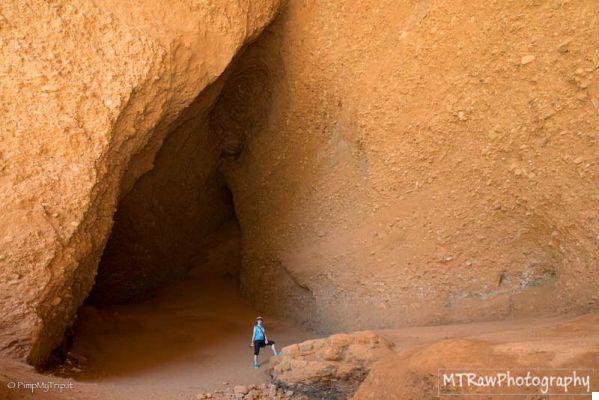
La Cuevona
We have chosen to leave the bike in the parking lot below, from where the guided tours also start, and to take one of the dirt paths that cross the woods. There are several and of various difficulty and length, whose map is posted on a sign near the parking lot and marked by colored arrows along the route.
Around one in the afternoon we took the yellow one Senda de las Valinas, the shortest and the steepest, but which also gives the greatest satisfaction.
We arrived at the Mirador de Orellán around 15:30 pm, after the usual panoramic photos, we waited until 16:00 pm for the visitor center to be open where, by entering the narrow underground tunnels of impalpable red earth, it is possible to understand what life the Roman miners.
On the way back, we reached two other points of interest consisting of two huge caves carved into the mountain: La Cuevona e The enchanted, where a sign illustrated the technique used by the Romans to extract the precious mineral. One last stop at Eagle Peak then return to the parking lot.
Day 11: Ponferrada, Astorga, Leon, Haro
The next morning we dedicated ourselves to visiting the historic center of Ponferrada, whose quiet streets meander among the beautiful ancient buildings among which the Clock Tower, the clock tower built by Charles V in the sixteenth century. From here the via del Reloj leads to Ponferrada Castle, built by the Templars in the XNUMXth century to protect pilgrims.
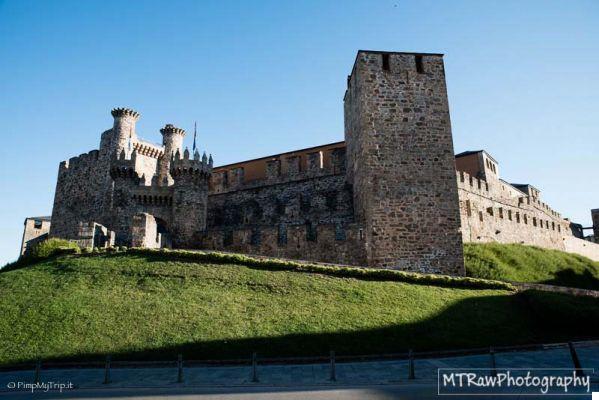
Ponferrada Castle
Unfortunately we could not walk on the ramparts as the entrance would only be open at 10:00 and we left at 9:00 to go to Astorga, another stage of the so-called French Way, which still leads pilgrims to Santiago de Compostela today.
The most impressive church building in the city is undoubtedly there Cathedral, elegant and grandiose, built around 1069 in Romanesque style and modified several times in the following centuries, to which various styles have been added: from Gothic to Baroque up to the current version dating back to the end of 1400, but further perfected up to 1700.
Not far away is the Episcopal palace, even if the building was never an episcopal seat, and today it houses the Museum of the Roads. Designed by the modernist master Antonio Gaudí at the end of the nineteenth century and finished in 1913, it is in neo-Gothic style with a Greek cross plan and spread over four floors.
After having rested in the wide Plaza Mayor, admiring the sumptuous main facade from the Town Hall of Astorga and drinking from the fountain, we left for León.
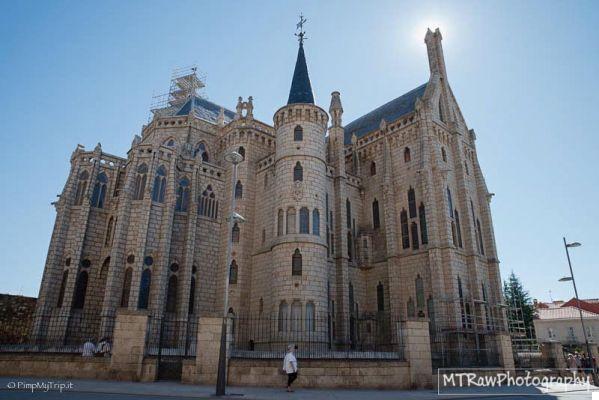
Episcopal Palace of Astorga
Much of the vejo helmet di León, the historic center surrounded by walls, is pedestrianized and the recent restorations have made it truly splendid. The main pedestrian thoroughfare, Wide street, leads to the imposing Cattedrale de León, whose towering spiers have guided pilgrims for centuries.
Still along Calle Ancha, you reach the Booty House, another Gaudí masterpiece, similar to a medieval-inspired neo-Gothic castle, imposing, almost austere, which is well suited to the sober beauty of Leon. Built to house the offices of prominent Leon businessmen in 1892, it is now home to a bank and exhibition space for temporary exhibitions.
The best place to admire it is the bench on which a statue of Gaudì himself is sitting intent on drawing the sketches of the project.
South of Calle Ancha, a maze of narrow streets forms the lively Humid neighborhood, where we tasted a delicious boccadillo stuffed with Cecina, a typical cured meat based on dried and smoked beef, and sweet and sour tomato sauce.
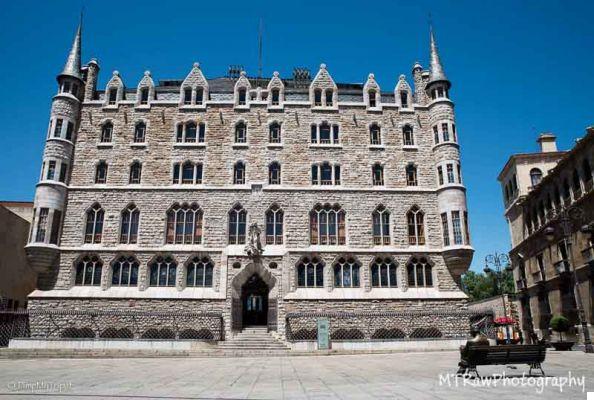
Botines House in Leon
In the evening we finally came to Haro, famous for being home to the most prestigious bodegas of Rojani Crianza wines. After checking in at the hotel we went for dinner in the pedestrianized historic center, crowded with tapas bars overflowing with tourists and locals.
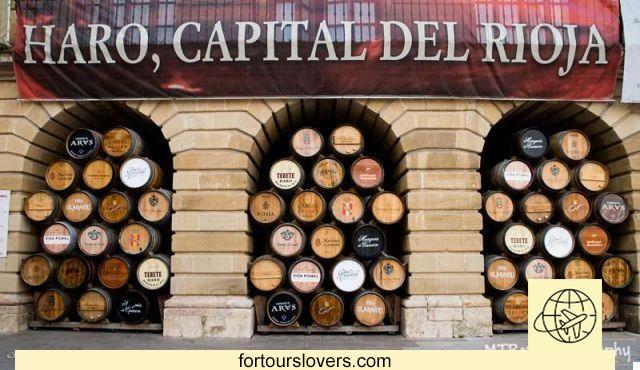
Haro's wines
Day 12: Tudela and Zaragoza
Departure for Zaragoza with a single intermediate stop a Tudela, where an unexpected stroke of luck caught us off guard: it was the feast of Santa Ana, the patron saint of the city.
All the locals, rigorously dressed in white and red, formed two “Indian” lines on the sides of the road, accompanying the statues of Sant'Anna and San Gioacchino in procession to the cathedral.
Particularly striking men, dressed in white shirts and trousers, a red scarf tied at the waist and a red scarf, with the emblem and writing "Tudela" or "Sant'Ana" embroidered with golden thread, knotted at the neck with the triangular part on the back. Not only that: even small children, even those in wheelchairs, were no exception.
And not even the dogs: they too are equipped with an appropriate red foularino as a collar. A real party, culminating with the opening of all the bars and restaurants, where people flocked once the procession was over to toast and eat in a huge popular festival including every single street in the center.
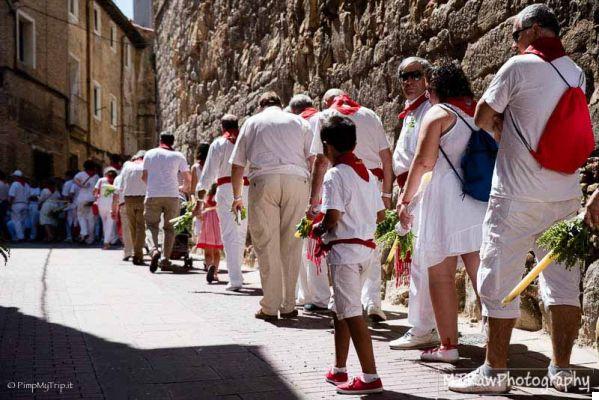
Feast of Santa Ana in Tudela
By mid-afternoon we came to Zaragoza and we dedicated ourselves to visiting this great city which, despite being an industrialized regional capital, boasts several splendid monuments.
Entering the pedestrian streets of the center, all recently renovated and full of luxury shops and boutiques, you reach the huge and beautiful Pilar Square, between the old city and the river, on which both cathedrals stand.
The older of the two, savior of The Seo, exhibits an incomparable mélange of styles, among which the original Gothic of the XII century, the subsequent Mudejar to finish in the Spanish Baroque.
The immense building has been thoroughly restored and is particularly striking for the contrast between the bricks with geometric ceramic inserts that cover the roof and the north facade and the eighteenth-century baroque of the main facade.
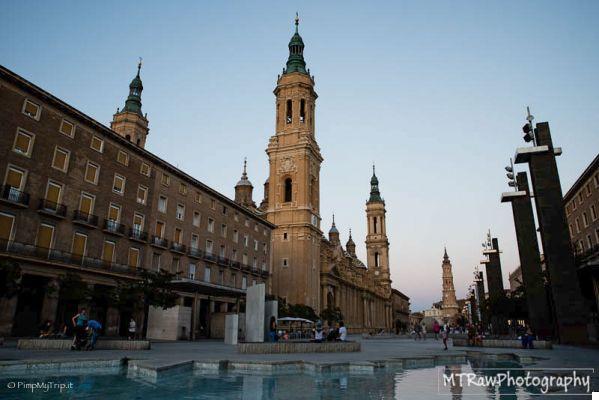
Plaza del Pilar to Saragozza
Also the Basilica of Our Lady of Pilar it is a jumble of styles and materials and was built around the column on which legend has it that the Madonna appeared to San Giacomo.
On the south side of the square there is the Fontana de la Hispanidad whose huge basin is shaped like South America, a tribute to the Hispanic culture in the world.
At dinner we ate very well in the Tapas bar Meli Melo, where we tasted various tapas of the highest quality both aesthetic and qualitative.
Day 13/14: Barcelona
And finally here we are back to the starting point: Barcelona.
I recommend booking a guarded parking lot near the place of stay at least a week in advance, there are many a Barcelona and in great demand, given the high frequency of vehicle thefts.
As it is easy to guess, a day and a half is not enough to fully visit this huge and fascinating city that offers so much to see; we therefore necessarily had to make choices.
On the afternoon of our arrival, after leaving the bike in the parking lot we had strategically booked 100 meters from our hotel, Hotel Transit, we dedicated ourselves to visiting the neighborhood where we stayed: Sants-Montjuic.
The neighborhood is one of the most crowded with bars, restaurants and clubs of all kinds. We chose to dine at The Fish &Chips Shop, a very small place where it is advisable to show up at least 20 minutes before opening to avoid the risk of being left with a dry mouth, and which offers various local or Indian dishes. Shopping for two: 30 euros with 3 large portions of fish & chips, 2 cervesas, 2 Gazpacho and 2 desserts.
The next day we chose the almost obligatory first destination Sagrada Familia, the huge and unconventional cathedral, Gaudi's unfinished masterpiece. Not having booked in advance we would have had to wait hours in line to enter and, given that time was running out, we decided to visit the district where the cathedral stands and which is full of modernist buildings, many of which also by Gaudi: the Eixample.
Here we have had the opportunity to appreciate, even if only from the outside, choosing to avoid the queues to be faced without online booking: Casa Mila; Casa Batllò; Calvet house; and finally Park Güell. The latter is actually just outside the neighborhood, at the foot of the Mount Carmel.
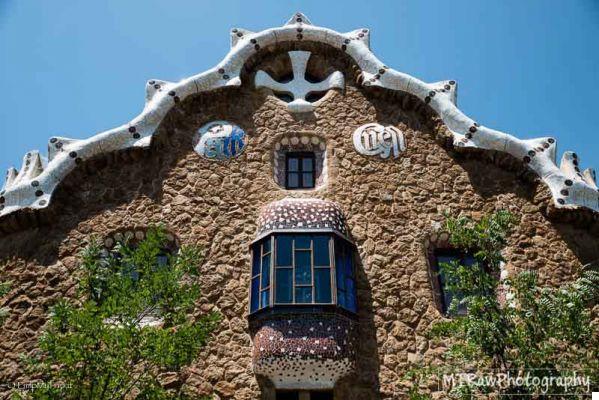
Detail of the entrance to Park Guell
The less touristy part of the park is free, while since 2013 the monumental part has become paid. Booking online from official website of Parc Güell, admission for adults costs € 7,50. When booking, you must indicate the day and time of the visit. Tickets can be shown directly from smartphone. Without reservation, it is still possible to try your luck at the ticket offices, where the price is increased by € 1, facing the risk of not being able to enter due to exhaustion of tickets, as happened to us.
It is advisable to show up at the entrance a little early, as they are quite zealous about the time and once you exit the monumental part it will no longer be possible to return with the same ticket.
Inside the park there is also the Gaudí House-Museum, where the great architect lived 20 years, but cannot be visited with the same ticket. Prices: full € 5.50, reduced € 4.50
Afterwards, we walked on the most famous street in Barcelona: La Avenue, crowded with stalls and street performers. About halfway we couldn't resist diving into the crowd that grabs the Boqueria market: here, among fresh food products of all colors, shapes and sizes, we enjoyed a refreshing slice of watermelon and a refreshing fruit juice.
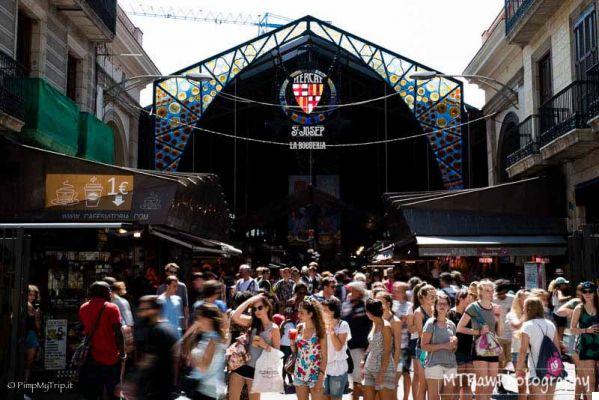
Boqueria market
Back in the neighborhood Sants-Montjuic, we lingered for a long time at the foot of the Fontana Magica, whose spectacle of water games can also be enjoyed from the top of the steps of the Palace National, home to the National Art Museum of Catalunya. Then we started shopping for souvenirs inside the futuristic shopping center Las Arenas, a completely modernized former bullfighting stadium, from whose top floor you can visit a breathtaking view of the entire district and the Montjuïc hill.
For dinner we went to a charming inn of very characteristic sailors, Maians restaurant, where we got rid of the desire for Paella: 2 large portions with the inevitable Cervesa and dessert at a cost of 40 euros.
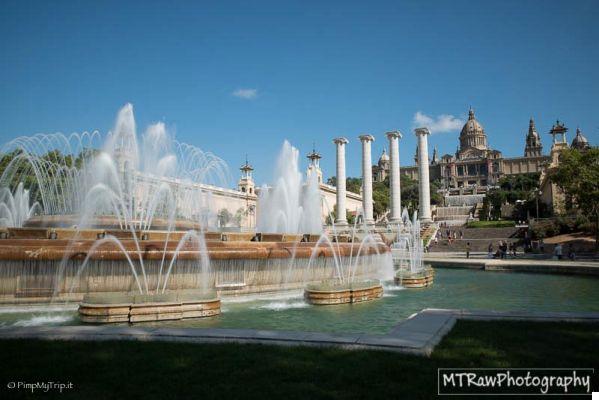
Magic Fountain and Palacio National
Finally, one last piece of advice regarding pickpockets: you need to have a hundred eyes! Unfortunately, it happened to me, in a moment of distraction, in the bar where we had our last breakfast before taking the return ferry. Purse gone, with all the documents inside. In this case, you must immediately go to the nearest police station where an interpreter will help you fill in the forms to file a complaint, with which it will be possible to embark.
And this is how this marvelous ends too motorcycle trip in Northern Spain.
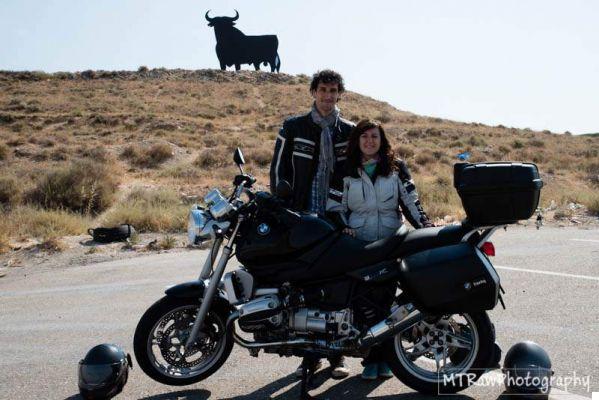
Serena and Marco, authors of the article and some beautiful photos
See you next time!




